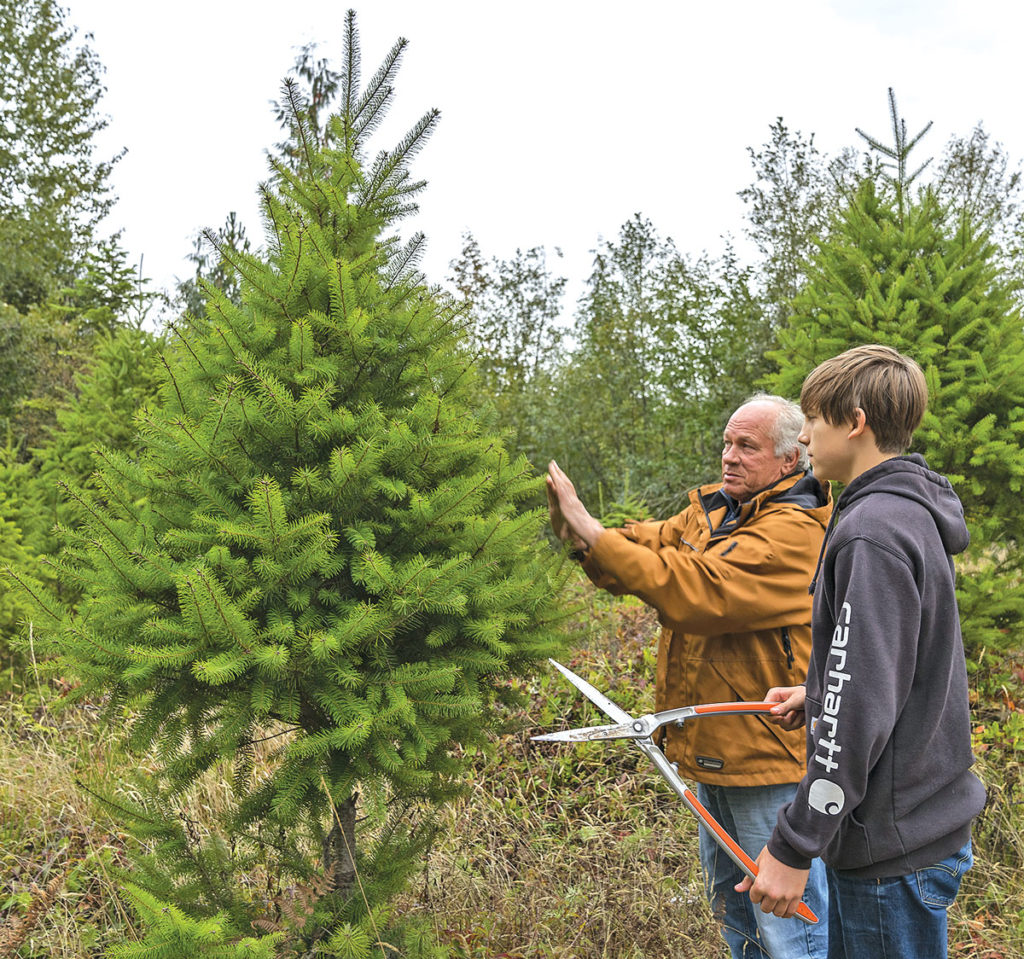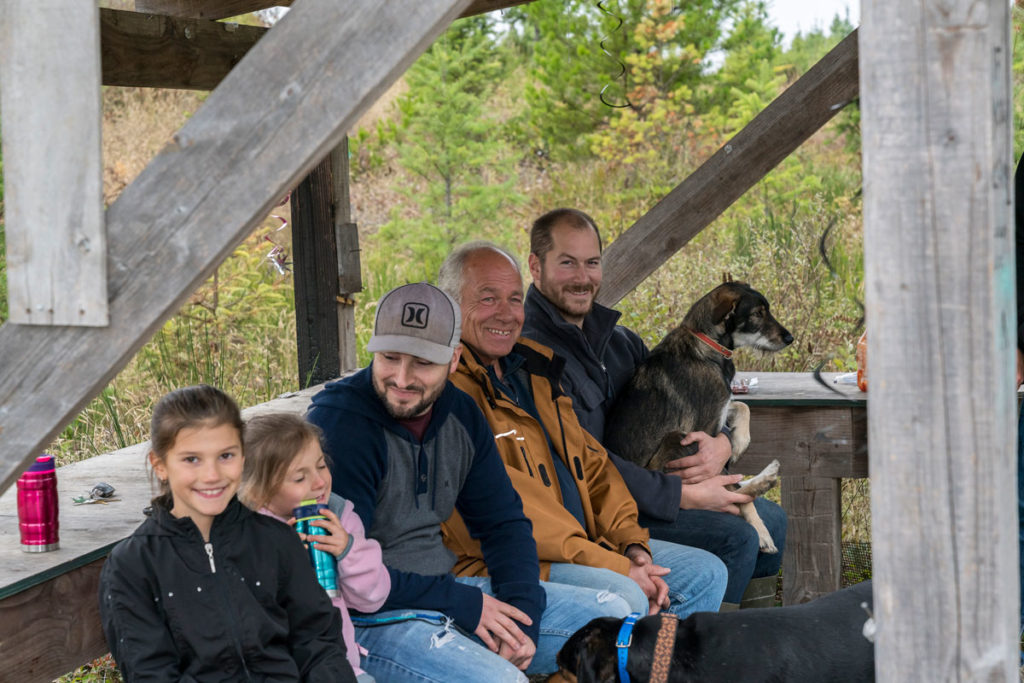Article by Shirley Culpin
Photos by Brian Argyle
A trip to the Whiskey Creek Tree Farm to cut Christmas trees has become an annual tradition for thousands in this area.
Families trek out en masse to the remote Melrose Road location that runs uphill along 40 hectares of hydro lines, traipse among the 50,000 trees, cut down the one that is perfect for them and finish the adventure with hot chocolate and hot dogs roasted over an open fire. The experience is a reflection of the ‘good old days’ that creates happy memories and family togetherness.
What none of us probably think about is just how much effort goes in to creating that perfect tree for us. The amount of work and expense is mind-boggling.
The Whiskey Creek Tree Farm was established in 1986 by Dave McBride who operated it until 2004, when it was purchased by Mica Verbrugge and his brother. Just in their twenties, the two young bucks came to Christmas tree farming naturally – their father for many years has run a similar smaller operation in the Alberni Valley and the boys had worked there on and off to earn pocket money.
Over the 13 years that the Verbrugge brothers have owned the tree farm things have evolved into a highly successful operation that offers employment and a special brand of Christmas cheer. But it hasn’t been easy – and it never will be. Christmas tree farming is an intense business that relies heavily on hard labour and the right weather.
The Whiskey Creek Tree Farm property is under lease from the Ministry of Forests, with an additional agreement from BC Hydro. That means that the farm has to meet a lot of government regulations, including no clear cutting and reforestation. The Verbrugges pay stumpage fees and take on the financial responsibility of road maintenance and repair leading to the u-cut site.
Each year between November and March, Mica and whatever hired help he can muster, plant 8,000 new trees, of many varieties.
“We have tried everything considered to be a Christmas tree,” says Mica. “Everything from the more common fir and pine varieties to redwoods and sequoias go into the ground. Normandy firs are a hot seller because they don’t drop their needles.”
Weather becomes a major factor at this point.
“On average, probably half the trees that we plant die,” says Mica. “Weather and terrain play a big role. If 4,000 survive that’s OK – anything less than that isn’t a great year. We don’t expect them all to make it.”
Other labour-intensive activity is also required to ensure tree saleability. Mica (and sometimes hired help) spend about 30 days a year ‘brushing’ – clearing out the weeds and blackberry vines that run rampant among the 50,000 trees on the site. Every viable tree is sheared annually to create the desired Christmas tree shape. When you consider that each tree takes an average of 14 years to reach the desired height, that’s a huge investment of time. Some years Mica is able to find casual labourers to help with the shearing, which takes an average of 1,500 hours. Other times he is on his own.
The shearing crew has to be conscious of trends when applying their talents. According to Mica, people no longer want the very dense trees that were popular a few years ago.
“They can’t get their decorations on those really dense trees,” he says. “So shearing is something of an art that has to be undertaken with care.”
700 dozen wieners
There are other big responsibilities in running the farm as well – some of them not so arduous as the aforementioned tasks. Mica and his companion Victoria Lake have spent a lot of time testing hot dogs to ensure that they offer the best at the hut, located next to the campfire. Patrons consume about 700 dozen wieners and hot dog buns annually, offering a happy ending to customers who can take a break, roast hot dogs over the campfire and enjoy a visit with each other once their Christmas tree quest is completed.
Each year the hut itself is more festively decorated, and Mica and Victoria are hoping to construct more huts that will house crafters making Christmas wreaths and other festive accoutrements for sale.
“We would really like to expand the Christmas experience by offering more to our customers,” says Victoria.
Finally, of course, there is the daily necessity of being at the farm once it opens for business (November 25 this year). At this point the tree farm involves more of the Verbrugge family – Mica’s Mom can often be seen at the site helping out, along with two or three of his nephews.
Generally there will be half a dozen employees to hand out saws, give directions to the cutting area, oversee the campfire, and collect money. Depending on the weather, 3,000 – 4,000 trees of all shapes and sizes will be loaded on to truck beds, in to vans or on top of cars, by the time the farm closes late on Christmas Eve afternoon.
One of the things Mica likes most about being at the farm during this period, is seeing what people choose to take home.
Charlie Brown Trees
“We still sell a lot of Charlie Brown trees,” he says, with a shrug and a smile. “Families let the kids choose the one they like, and it’s pretty shocking sometimes what people will buy.” The farm also offers between 50 and 100 pre-cut larger trees each year.
“People with larger homes are often looking for a bigger tree, so we save them the hassle of tramping around out there and display them at the fire pit area,” he says.
The Whiskey Creek Tree Farm is one of the last of a dying breed. According to Mica, there used to be about 20 tree farms between Comox and Nanaimo.
“I think we are pretty much the only one now,” he says.
That’s not difficult to believe when you realize how much work, time and expense goes in to creating that perfect Christmas tree – something to think about when its glittering presence brightens your home over the Yuletide season.
The Whiskey Creek Tree Farm is located at 3827 Melrose Rd. Visit their Facebook page at
www.facebook.com/whiskeycreektreefarm

